Building Muscle Without the Gym: Effective At-Home Exercises
Introduction:
In today’s fast-paced world, finding time—or the budget—for regular gym sessions can be challenging. However, building muscle at home is not only achievable but highly effective. By utilizing proven at-home exercises and simple strategies like exercise snacking, you can build strength and size without expensive equipment. This comprehensive guide dives deep into how to create an optimized at-home workout plan, focusing on sustainable muscle growth, flexibility, and results-driven routines.
Why Should You Train at Home?
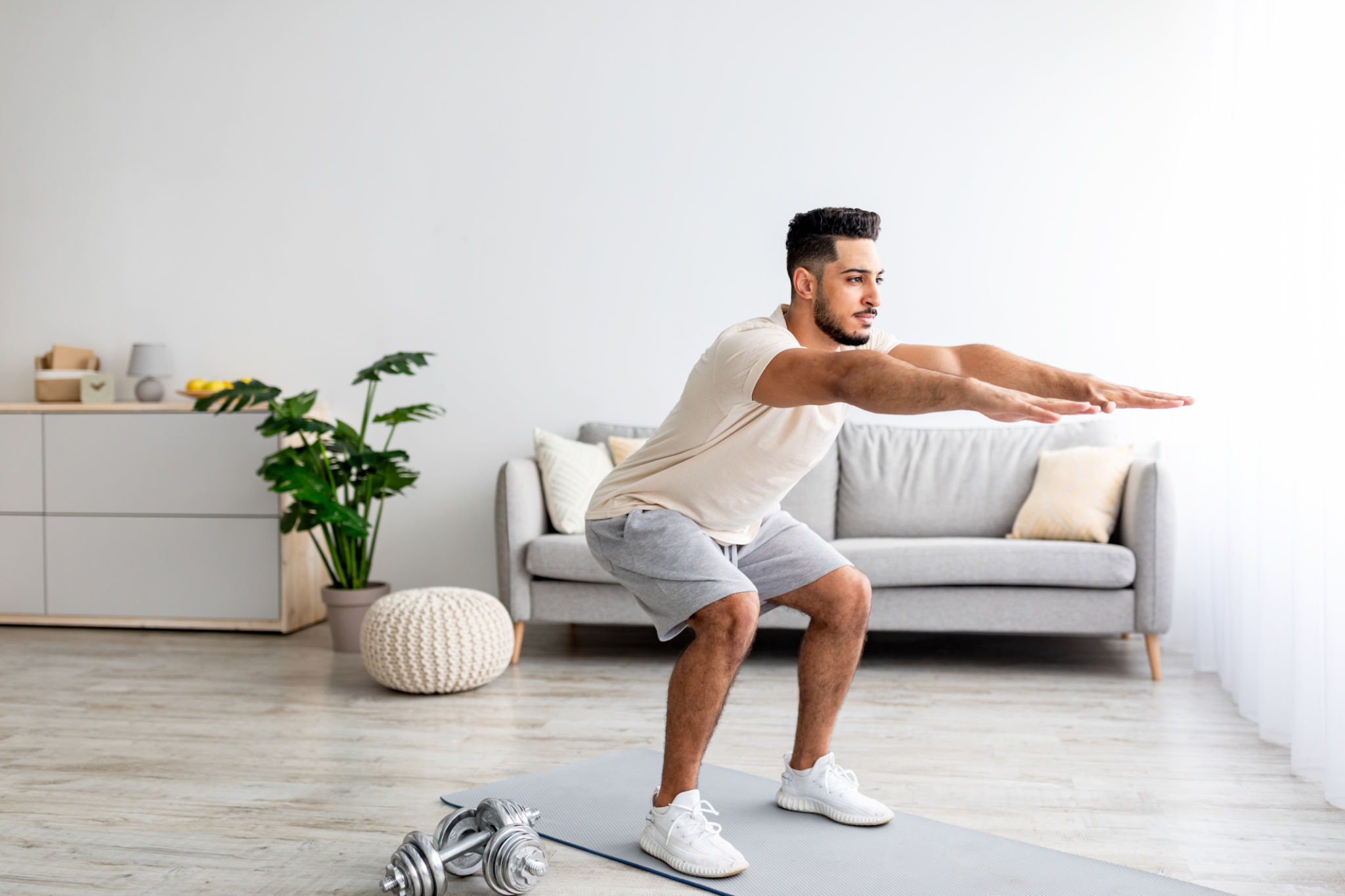
Training at home offers unparalleled benefits that cater to a wide range of fitness enthusiasts:
- Flexibility: Work out at any time that suits your schedule. Whether it's early morning, a lunch break, or late at night, at-home workouts adapt to your routine.
- Affordability: Skip expensive gym memberships and invest in minimal equipment or use household items to achieve your fitness goals.
- Privacy: Enjoy exercising without feeling self-conscious or dealing with crowded gyms.
- Functional Strength: Focus on bodyweight exercises and movements that mimic real-world activities, which build a foundation for long-term fitness.
How to Build Muscle Without Heavy Weights
Muscle growth, or hypertrophy, relies on several principles that apply whether you're lifting heavy weights or doing bodyweight exercises at home. Here's a deeper dive into these critical factors:
- Increasing the intensity of your routine slowly:
Our muscles are to be consistently pushed to see results. Challenge them by:
- Increasing repetitions: Add reps to your exercises as they become easier.
Adding weight: Use household items like filled backpacks or water bottles. - Advancing difficulty: Progress to harder variations of exercises, such as moving from standard push-ups to archer push-ups or one-arm push-ups.
2. Time Under Tension (TUT)
Time under tension refers to the duration your muscles are actively engaged during a movement. Here's how to optimize TUT:
- Perform each movement slowly, emphasizing both the concentric (lifting) and eccentric (lowering) phases.
- Add pauses at the most challenging parts of an exercise. For example, pause at the bottom of a squat or halfway through a push-up.
3. Recovery
Muscle repair happens during rest, not during the workout itself. Ensure you:
- Get restful sleep for about 7–8 hours every day to help your muscles recover.
- Stay hydrated to optimize cellular repair.
- Incorporate active recovery days with stretching or yoga to improve flexibility and blood flow.
4. Nutrition
Fueling your body is just as important as the workout itself. To aid your muscle growth, incorporate health fats, protein-rich foods, and high-quality carbs into your diet. Popular home snacks include boiled eggs, nuts, Greek yogurt, and protein shakes.

Best At-Home Exercises for Muscle Building
Below is an expanded list of at-home exercises categorized by muscle group, with additional tips for progression and variation.
- Chest, shoulders, and triceps (upper body)
Push-Up Variations: Push-ups remain a cornerstone exercise for building upper body strength. Variations ensure you continue to challenge your muscles:
- Clap Push-Ups: Build explosive power and target fast-twitch muscle fibers.
- Pseudo Planche Push-Ups: Shift your weight forward to engage the shoulders and core more intensely.
- Wide arm push-up: Do push-ups with wide arms by placing your hands wider than your shoulder width in a plank position.
- Pike/Elevated Push-Ups: Simulate overhead pressing by performing pike push-ups. Elevate your feet on a surface to increase the difficulty and eventually work toward handstand push-ups.
- Classic Push-Ups: Target the chest, shoulders, and triceps. Maintain a proper posture and lower yourself until your chest nearly touches the floor.
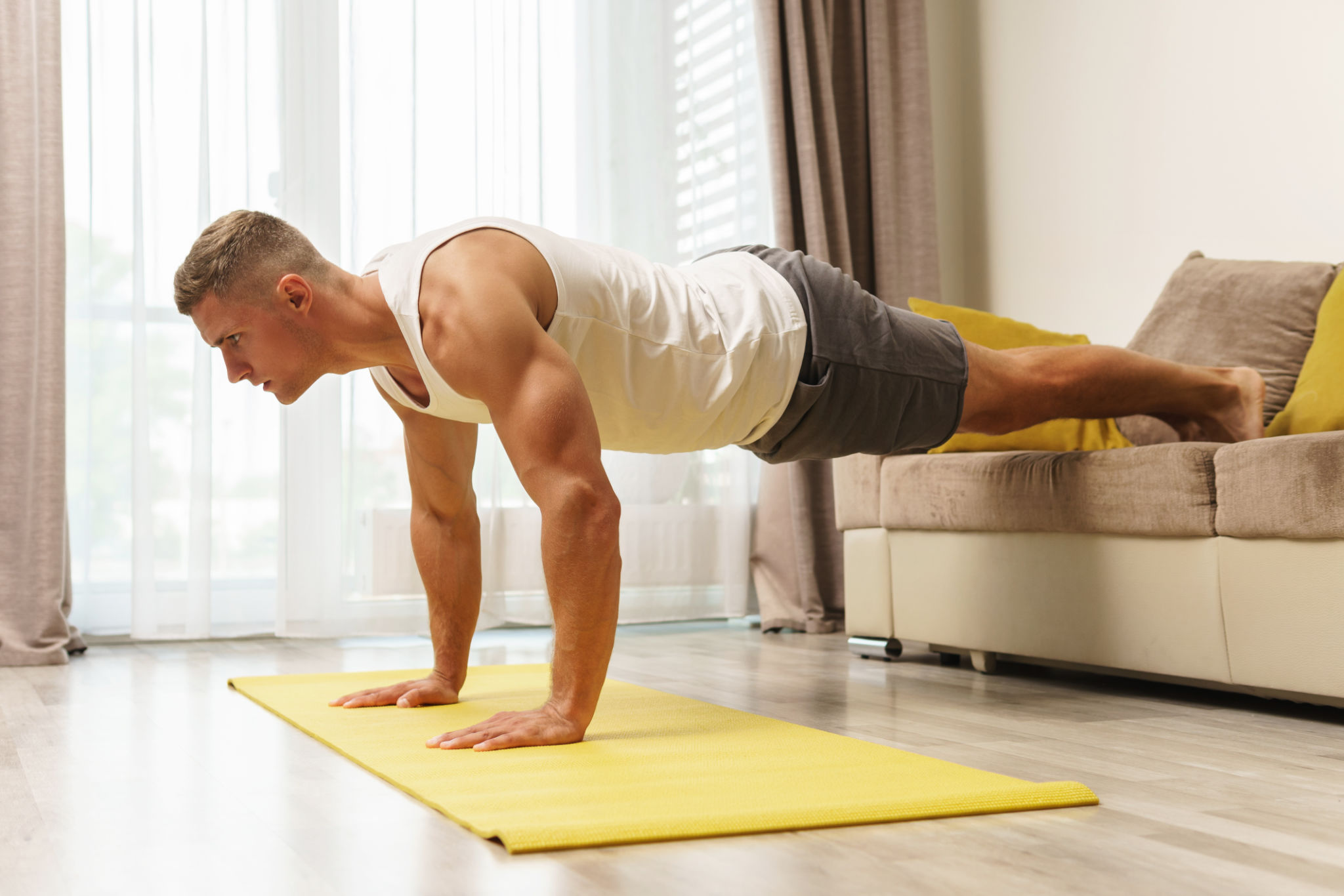
Sculpt triceps with chair dips.
Chair dips are simple yet effective. Sit on the edge of a sturdy chair with your hands gripping the seat. Move your hips forward, that is, away from the chair, and lower your body using your arms. Push back up and keep repeating the movement. Increase intensity by extending your legs or placing your feet on another elevated surface.
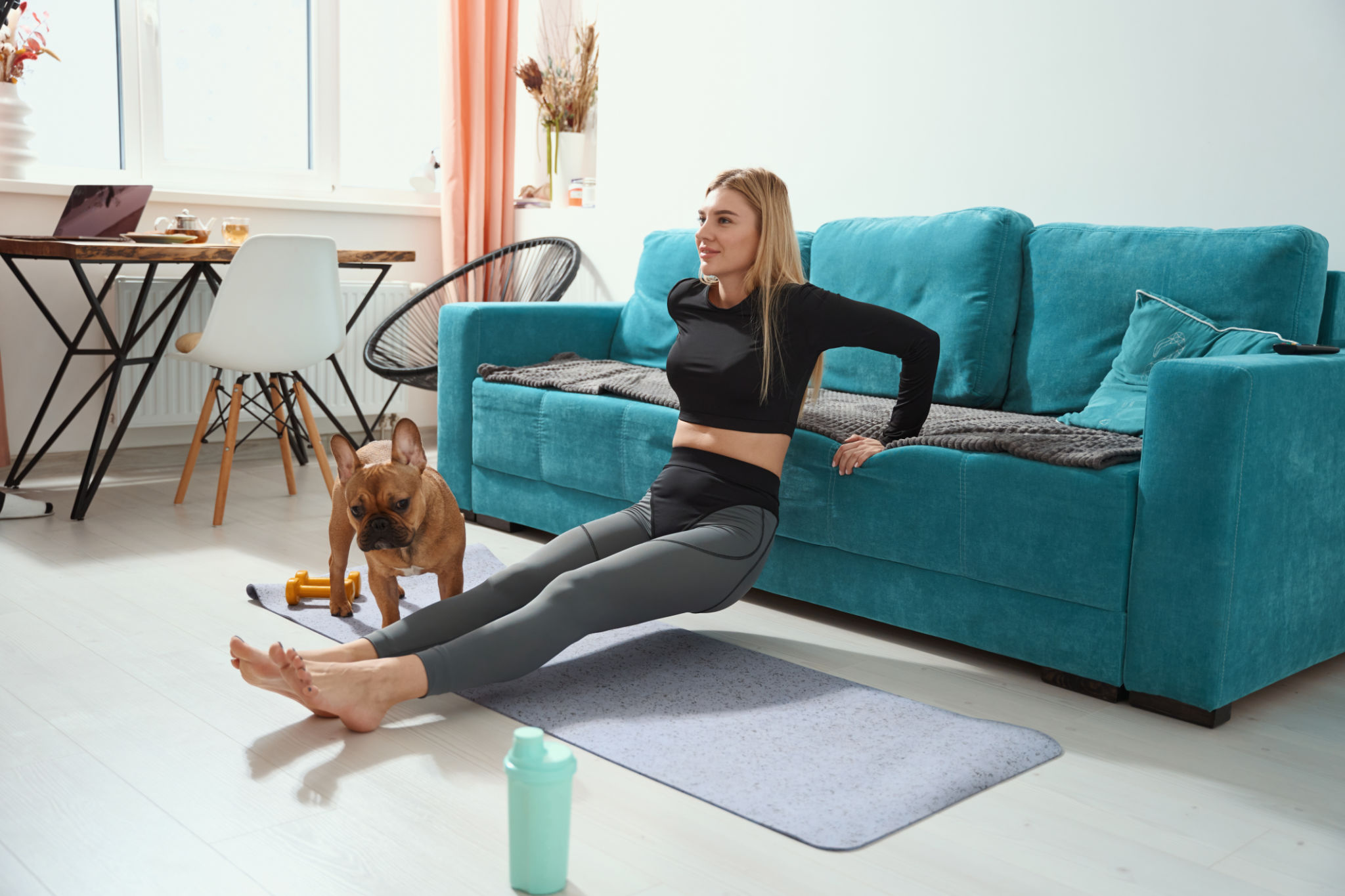
2. Core Strength: Abs and Obliques
a. Plank variations
Planks are a staple for core training, offering full engagement of your abdominal muscles, back, and shoulders.
- Classic Plank: On a yoga mat, lie on your stomach and raise your body to a plank position. Hold the pose for 30—60 seconds. The time may vary depending on the intensity of your workout.
- The Side Plank: This pose involves lying on your side, placing one leg on top of the other, and raising your hips off the ground. Hold it for 30—60 seconds.
- Plank Shoulder Taps: While in a high plank, alternate tapping each shoulder with the opposite hand, ensuring your hips stay stable.

Side plank
b. Leg Raises
This is the perfect exercise to target your belly pouch.
- With your back on the yoga mat and your hands at your sides, raise your legs to be perpendicular to your hips and gradually lower them back.
- Perform 10–15 reps for 2-3 sets.
c. Bicycle Crunches
This exercise targets the belly pouch and obliques.
- Lie flat on the ground with your back down and extend your arms overhead.
- Perform a one-side crunch by raising your left elbow to your right knee with the left leg still straight.
- Repeat the same motion on the other side, performing 20 reps per side.
d. Mountain Climbers
This high-energy move engages your core while also providing a cardiovascular boost.
- Lie on your stomach and raise yourself off the ground like you are doing a push up and engage your core.
- Raise your right knee to your stomach and back out. Repeat the same with the left knee.
- Perform this exercise for 30–60 seconds, keeping your hips level throughout.
e. Dead Bug
This workout helps strengthen your core. To do this:
- While lying on your back, raise your knees and arms to the ceiling.
- Slowly lower your left arm and right leg toward the floor. Make sure to engage your core.
- Go back to the dead bug pose and repeat the movement on the other sides. Perform 10–12 reps per side.
f. Russian twists
This twisting motion helps target the abdominal side muscles.
- While lying on your back, bend your knees slightly and lift your feet off the floor.
- Try lifting your upper body and rotating your torso right and left.
Aim for at least 15 reps of torso twists per side.
g. Hollow Body Hold
This static hold is excellent for building isometric core strength.
- With your back on the mat, stretch out your hands and legs
- Begin the boat pose, but stretch out your hands above your head with your upper body close to the floor.
- For 30 seconds, hold the position. As you progress, you can gradually increase the duration.
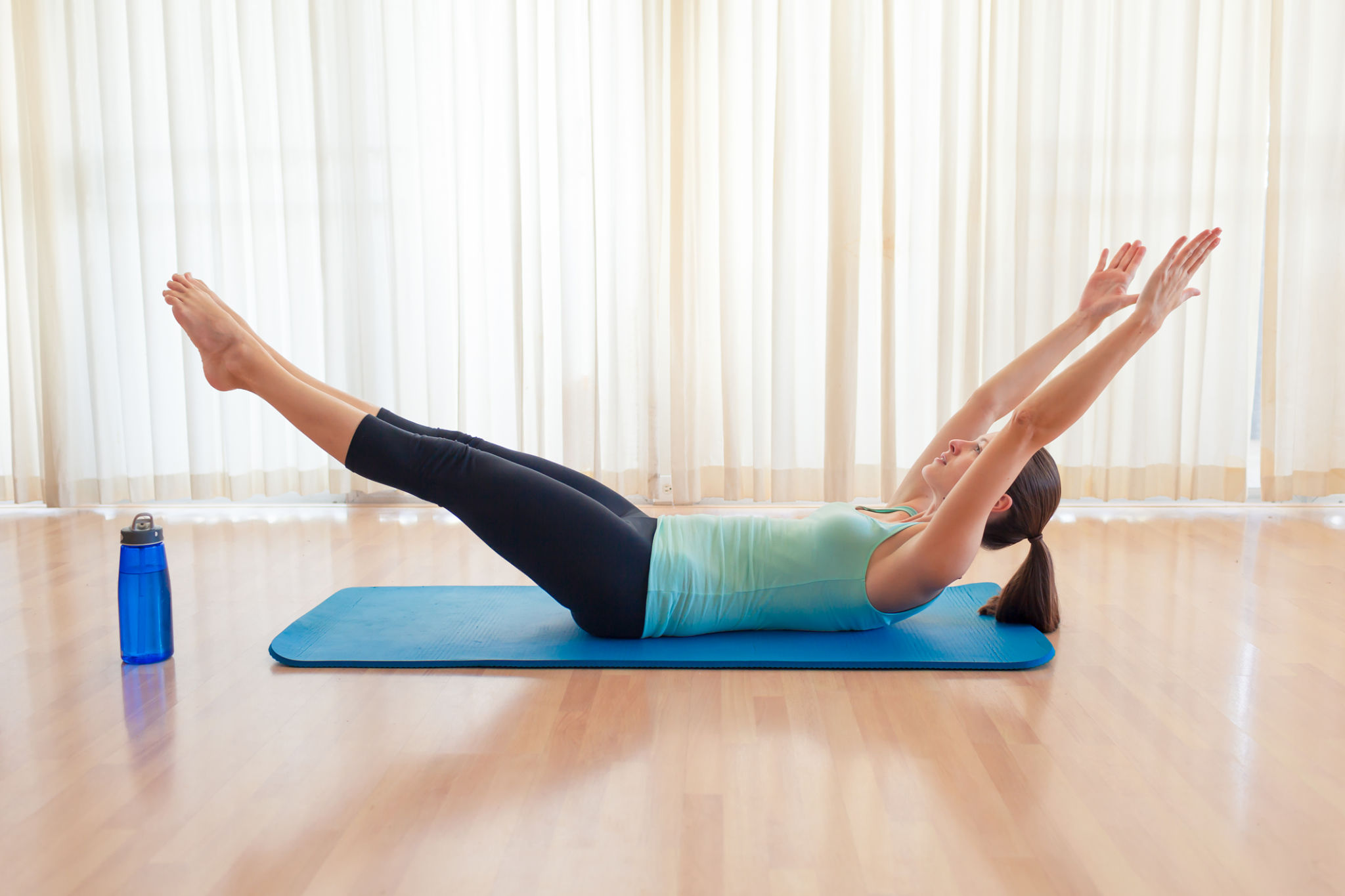
3. Legs and Glutes (Lower Body)
Lower-body exercises are critical for functional fitness and calorie-burning potential.
- Bodyweight Squats: Add depth by pausing at the bottom or incorporating a jump at the top for explosive power.
- Lunges: Enhance the challenge with multi-directional lunges (forward, reverse, and lateral). This variation engages stabilizer muscles and improves balance.
- Step-Ups: Use a sturdy bench or chair and focus on controlled movement. For added intensity, hold a loaded backpack or dumbbells.
- Glute Bridges: For increased glute engagement, place your feet on an elevated surface like a couch or use a resistance band around your thighs.
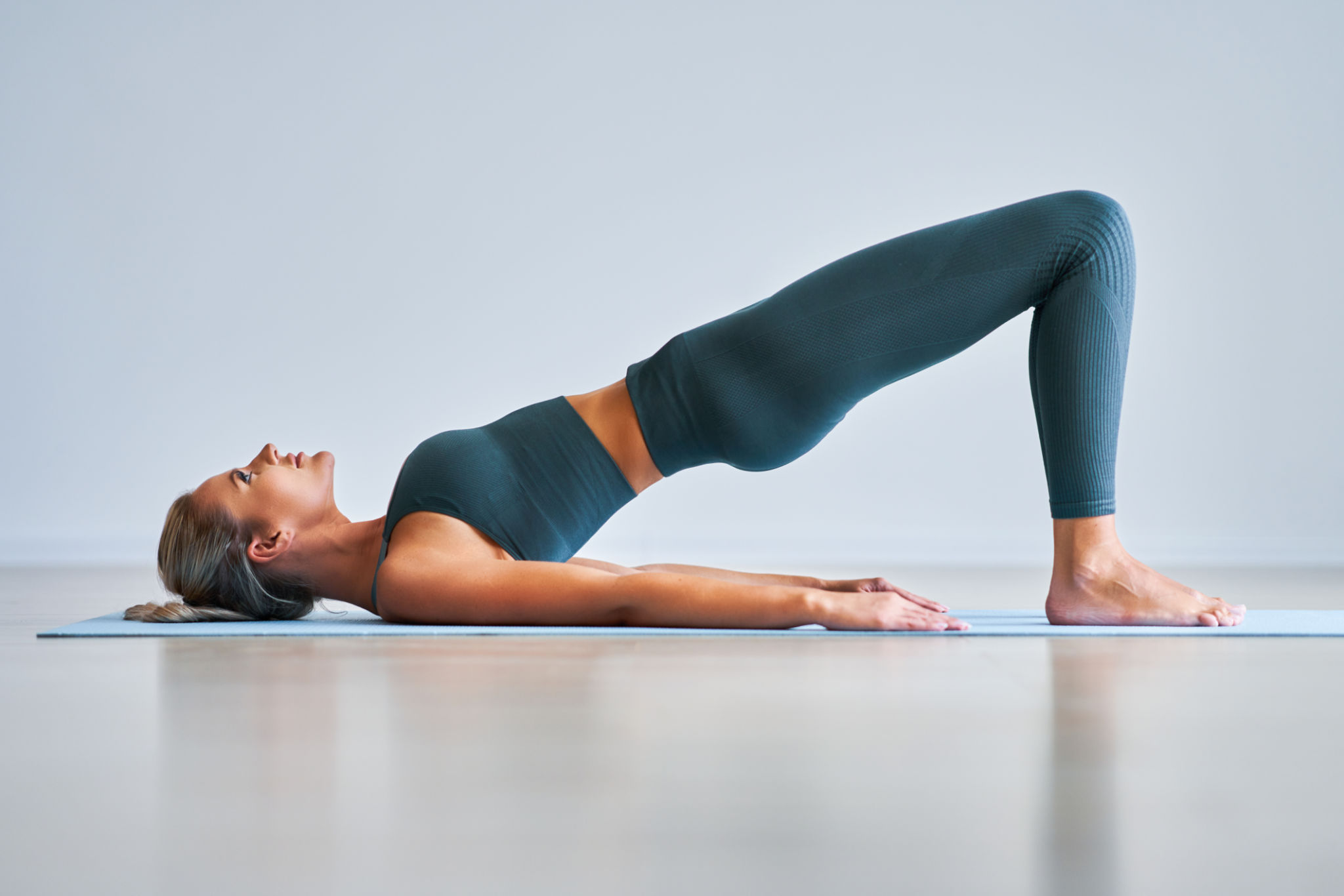
Glute bridge
4. Back and Biceps
Strengthening your back improves posture and supports other movements.
a. Inverted Rows (Underhand Grip)
Inverted rows are one of the best exercises for targeting your back and biceps. If you have a sturdy table or any horizontal surface that can support your body weight (like a broomstick balanced across two chairs), This exercise is incredibly effective.
How to do it:
- Lie underneath the surface and grab the edge with both hands, palms facing toward you.
- Keep your body aligned with your feet planted firmly on the ground.
- Bend your elbows to raise your chest, engaging your back muscles as you do so.
- Slowly lower your body back down to complete one rep.
Tip: The closer your feet are to the surface, the easier it will be. For more difficulty, extend your legs and raise your feet on a platform to make the movement more challenging.
b. Superman Hold
The Superman Hold is an excellent exercise for targeting the muscles in your lower back and improving overall back strength.
How to do it:
- On your yoga mat, lie flat on your stomach with your hands stretched out in front of you or holding your head.
- Imitating a flying superman, raise your legs, chest, and arms off the ground, squeezing your glutes and lower back.
- For 30 seconds, hold the position.
- Lower back down slowly and repeat for 3–4 sets.
Tip: To make it harder, try holding the position for longer or add small pulses to increase time under tension.
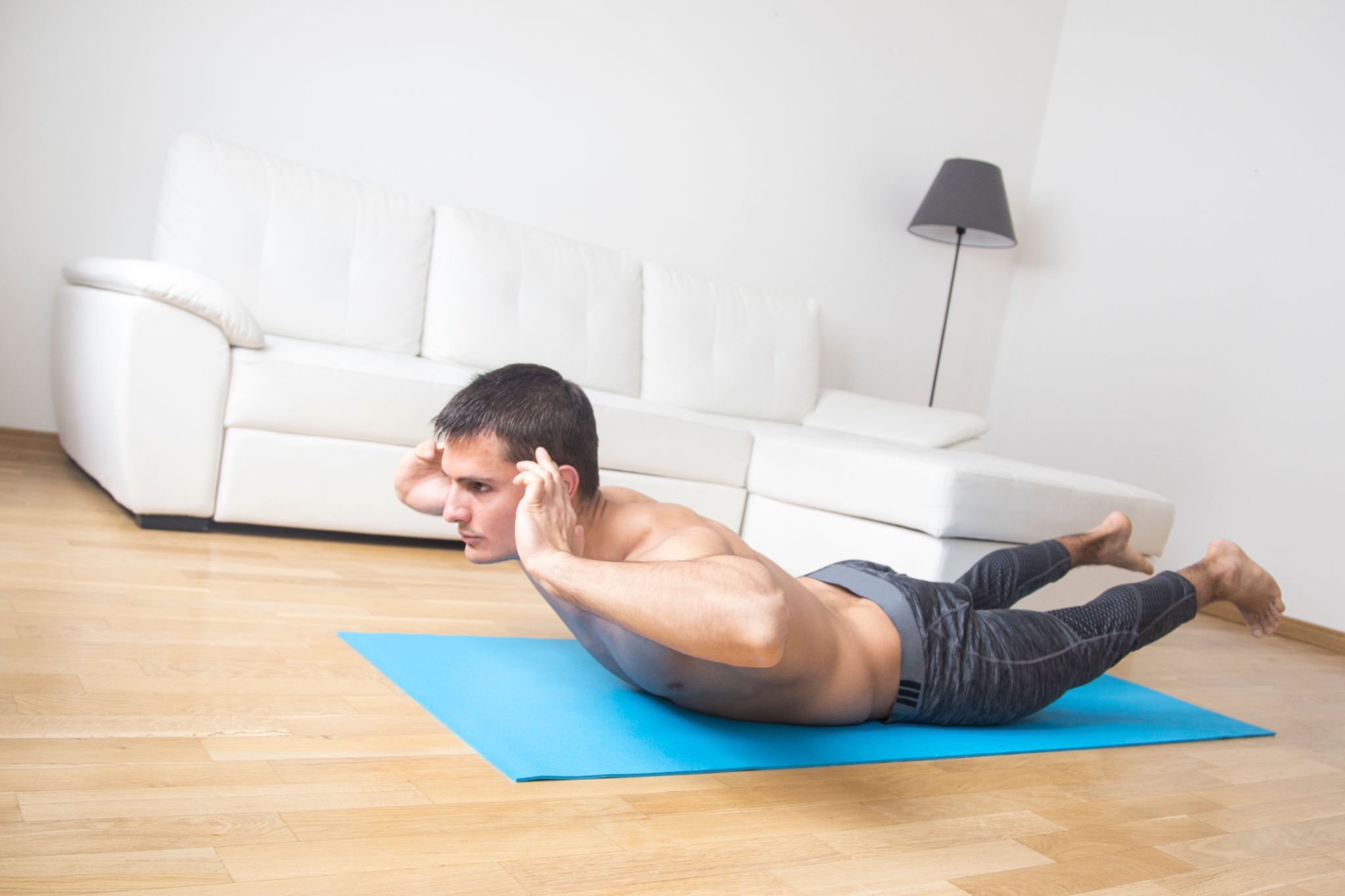
c. Doorway Rows (Bodyweight Rows)
If you don't have access to a horizontal bar, you can still perform an effective row by using a sturdy doorway. Doorway rows mimic the movement of a traditional row and engage your biceps and back muscles.
How to do it:
- Stand in front of a doorway and hold the doorframe with both hands.
- Lean back while keeping your body straight and feet planted firmly on the ground.
- Pull yourself toward the doorframe by bending your elbows and engaging your back muscles.
- Gradually return to the starting position and perform the movement again.
Tip: Adjust the angle of your body to make the exercise easier or harder. A steeper angle (closer to the floor) will increase the intensity.
d. Towel Curls
You don’t need dumbbells to work your biceps—use a towel to create resistance! This simple exercise effectively targets the biceps, and all you need is a towel and a sturdy door or any horizontal bar that you can hang the towel over.
How to do it:
- Drape a towel over the top of a closed door or any sturdy horizontal surface.
- Grab both ends of the towel with your hands.
- Lean back slightly and pull on the towel as if you're performing a bicep curl.
- Use your biceps to pull yourself toward the towel and slowly lower yourself back down.
Tip: The more you lean back, the more challenging the exercise becomes.
5. Full-Body Movements
Full-body exercises efficiently combine strength and cardio for a high-impact workout.
- Burpees: Modify the movements to suit your fitness level. Add a push-up or jump higher to increase difficulty.
- Bear crawls: Add resistance by wearing a weighted vest or backpack.
- Shadow Boxing: Incorporate footwork and core twists for a more dynamic routine. Use light dumbbells to simulate punching with resistance.
How to Maximize Your At-Home Workouts
1. Use What You Have
You can substitute household items for gym equipment. For example:
- Use a broomstick balanced across two chairs for improvised pull-ups.
- Load reusable grocery bags with canned goods for farmer’s carries.
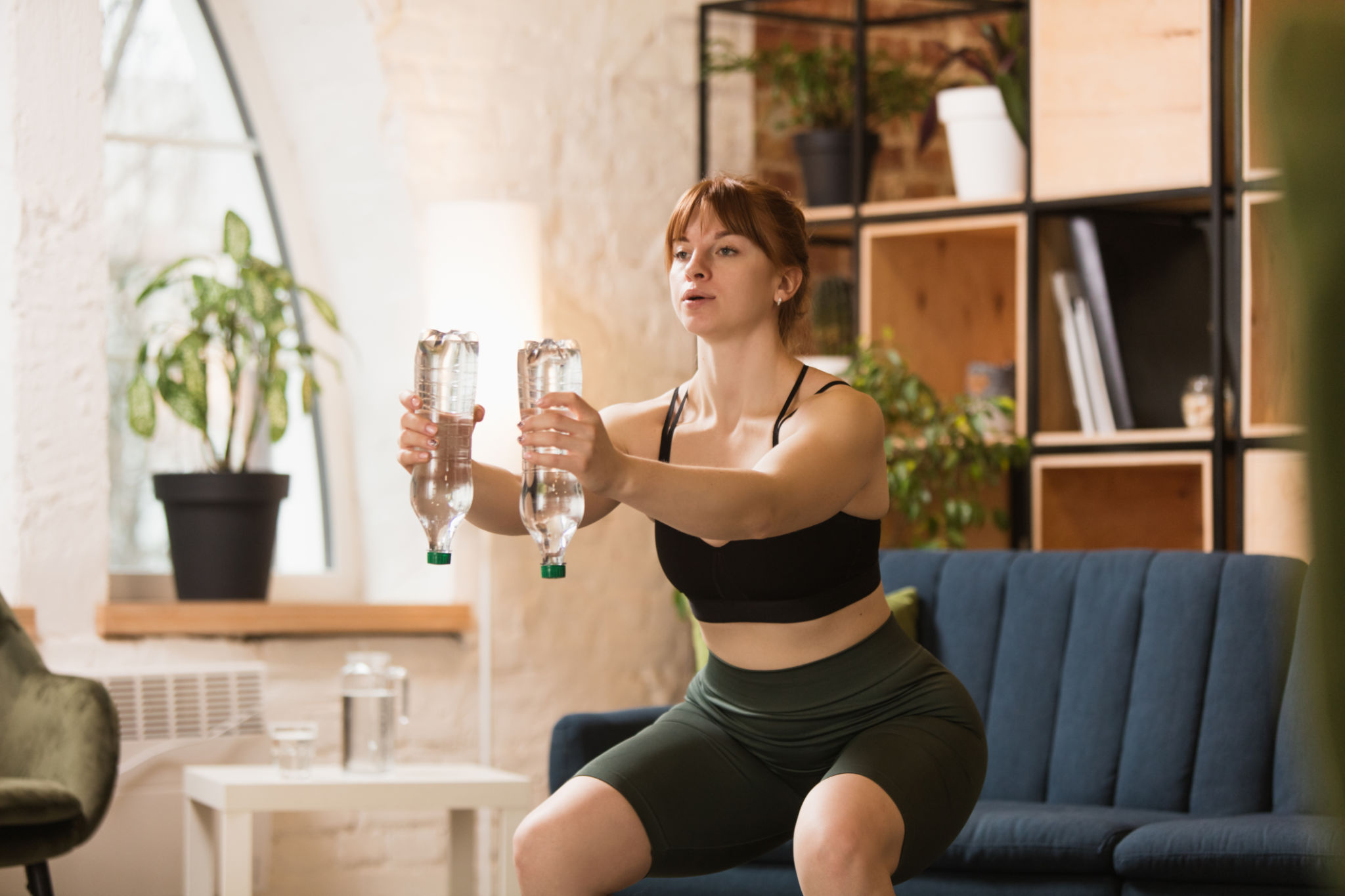
2. Create a dedicated workout space.
Choose a spot in your home where you can move freely. Clear the area of distractions and equip it with essentials like a yoga mat, resistance bands, and a timer.
3. Stay Consistent
Consistency beats intensity. Commit to a schedule that fits your lifestyle, even if it's just 20 minutes a day.
4. Challenge Yourself
Every two weeks, reassess your workout plan. Are you adding reps or advancing to harder variations? If not, adjust your program to maintain progress.
5. Maintain Proper Form: Avoid arching your back or letting your hips sag during exercises.
6. Fuel Your Efforts: Pair your workout routine with a balanced diet to support muscle development and fat loss.
Example of a 4-Week At-Home Workout Plan
Day 1: Focus on the upper body
- Elevated Press-Up: 3 sets of 15 reps
- Deadlift with a resistive band: 4 sets of 8 repetitions.
- Triceps kickback: 4 sets of 8 reps
Day 2: Lower Body Workout
- Goblet Squats: 4 sets of 15 reps
- Bulgarian split squats: 3 sets of 8 reps for each
- Glute Bridges: Perform 3 sets of 20 repetitions.
Day 3: Core workouts
- Bird dog: Perform three sets of 15 repetitions per leg.
- Dead bug: Perform 3 sets of 30 seconds
- Russian twist: 4 sets of 18 reps
Day 4: Rest
Day 5: Full-Body Challenge
- Burpees: 3 sets of 12 reps
- Bear Crawls: 3 sets of 40 seconds
- Dumbbell thrusters using two filled water bottles: 3 sets of 15 reps.
Weeks 3–4 Adjustments
- Add weighted resistance.
- Incorporate new variations, such as sumo squats or one-arm push-ups.
- Decrease rest periods for a cardio boost.
FAQs about muscle building at home
- Can you build muscle with body weight alone?
Yes! Bodyweight exercises, performed regularly with progressive overload, are effective for muscle growth. - How Long Until You See Results?
You can expect noticeable improvements in strength and muscle tone within 4–8 weeks, depending on regularity and nutrition. - Do You Need Equipment?
Not necessarily. While equipment can add variety, you can achieve substantial results with bodyweight exercises and household items.
Final Thoughts
Building muscle at home is doable, cost-effective, and empowering. With the right strategy, consistent effort, and creativity, you can develop a balanced, strong physique. Remember, the best workout is the one you enjoy and can stick to over time. Explore fun ways to make your workouts enjoyable, ensuring you stay motivated and consistent on your fitness journey.